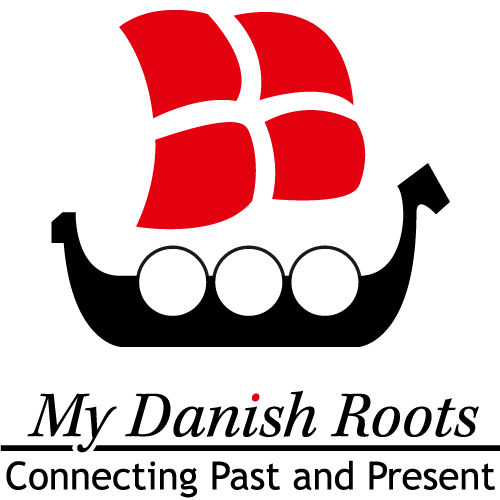Danish Traditions
The general traditions as they are practised or known by the Danes
January 1

New Year’s Day tradition
This is a fun little tradition that came about in 1959, when DR (the state television radio/TV) started televising the ski jump competition in the German city of Garmish-Partenkirchen. It seems that it has mainly become a tradition due to ski jumping being easy and relaxing to follow on TV, after a night of partying and while some are still hung-over.
The last Danish Championship was in 1970 and today there are virtually no ski jumpers in Denmark.
Roughly 300.000 viewers tune in to this relaxing event on January 1st.
Night of January 5
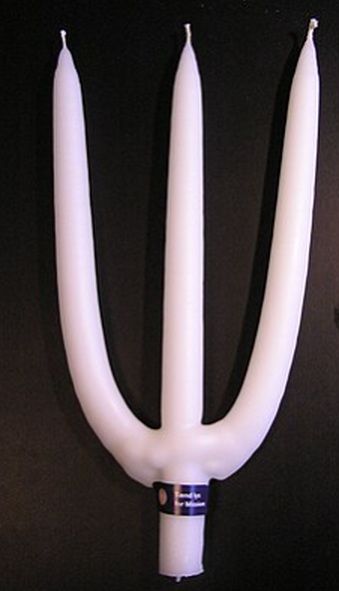
Twelfth Night – Helligtrekongersaften
In some places, people play pranks on the Twelfth Night, just like on New Year’s Eve. In other places, people light candles and remove all Christmas decorations. When the candles burn down, it marks the end of Christmas. In the old days, there was gunpowder in some of the Twelfth Night candles which are shaped like a fork with three connected candles, belong to an old tradition.
January 6
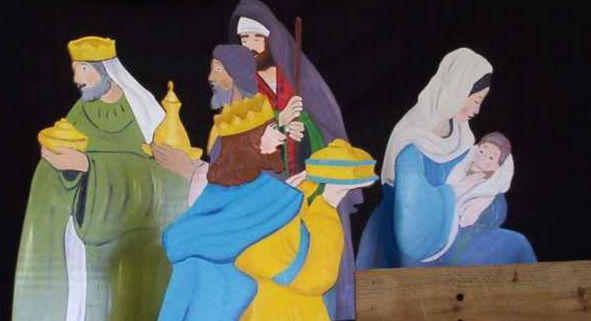
Epiphany – Helligtrekongersdag
Epiphany marks the day when the wise men from the East visited Jesus in the manger after his birth on Christmas night. It is not a public holiday in Denmark, and for most Danes Epiphany is nothing special and the day is rarely celebrated in Denmark.
Ferbuary 14

Valentine’s Day – Valentins dag
Celebrating Valentine’s Day in Denmark is a relatively new tradition. It took time to get Valentine’s Day introduced in Denmark. The day even came to the country several times. The first time Valentine’s Day tried to be introduced in Denmark was in the 1950s. Danish florists tried hard to kickstart the tradition, but without success. It was not until the late 1990s that the Danes took to the day. In the 2000s, Valentine’s Day became bigger and it began to be celebrated across the country.
Despite the fact that Valentine’s Day in Denmark is becoming more and more popular every year, the day means a lot more in other countries, where the day is marked as a national holiday.
February (49 days before Easter Sunday)
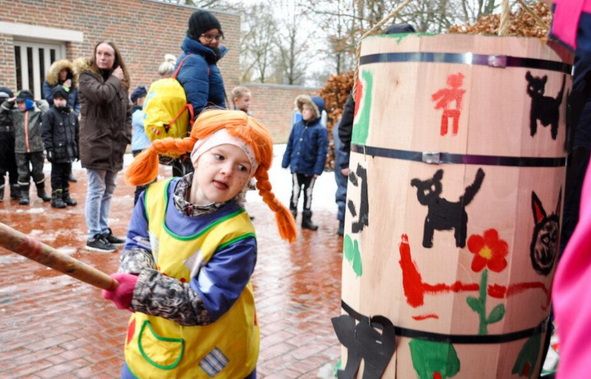
Shrovetide – Fastelavn
Fastelavn (Shrovetide) was originally a party for adults, but today Fastelavn is primarily a party for the children, who can dress up and knock the cat out of the barrel. It has been a widespread folk belief that a town could escape the plague if a black cat was killed. That is why cats have lived life dangerously throughout Europe at Shrovetide.
In Denmark, the black cat got into a barrel, where it was mistreated while the barrel was broken into pieces. When the barrel was broken, the children could beat the mischievous cat to death with a stick. This custom was stopped in 1830. Today, costumed children knock the cat out of the barrel without a live cat in the barrel but a lot of candy, and with a picture of a black cat on the outside.
Today, a cat king is chosen in connection with the barrel beating. There are different ways to become cat king in the country and from district to district. In addition, a cat queen is usually also chosen. The rules are confusingly different for who becomes queen or king.
The rustle, where costumed children go around begging and sing “Fastelavn is my name” or similar songs, is also a Fastelavn tradition. They go around the neighborhood singing at the door to get money, Shrovetide buns or candy, with a threat in the back of their hand:
Fastelavn is my name,
I want buns.
If I don’t get buns,
then I make trouble.
Buns up, buns down
buns in my stomach.
If I don’t get buns,
then I make trouble.
A few days before Easter
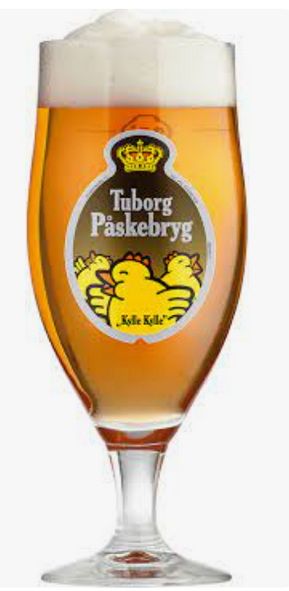
P-day – P-dag
P-day – “P” stands for “Påskeøl” (Easter ale) – is the day when the year’s Easter brew is launched. It happens a few days before Easter and all pubs are only allowed to sell beer after 8:59 pm. A similar day is J-day.
P-day was previously – not least in the 1980s and 90s – the primary beer celebration, where students at the universities started the day with Easter brew and shots (“Gammel Dansk”), and intoxicatedly attended the lectures.
It was also common to mark P-day at high schools; this was possibly the reason why P-day was downplayed by the breweries.
Earliest March 22 – latest April 25
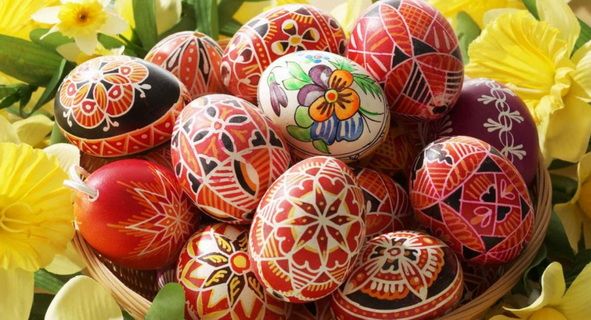
Easter – Påske
Easter in Denmark runs from Thursday (Maundy Thursday) to Monday (2nd Easter Sunday), but many people take the three weekdays off until Easter.
There are many traditions associated with Easter in Denmark.
An Easter egg is a normal chicken egg, where you blow out the white and yolk by making two holes in the egg. You then paint your egg or decorate it in another way, e.g. with glitter and feathers. This is an activity that especially children find fun and challenging, and which is often seen in kindergartens and institutions.
Sending a “gækkebrev” [a letter where the receiver is asked who the sender is] to each other is actually a tradition that originated in Denmark over 300 years ago. It involves sending an anonymous letter in which there is a small riddle that the receiver must solve in order to guess who the sender is. If the receiver cannot solve the riddle, that person owes the sender a chocolate Easter egg. Many schools allow younger students to write such letters in class, as they can be both fun and creative. The “gækkebrev” got its name because in the old days a snowdrop was sent in the letter. And “to gække” means to mislead, which is the purpose of the riddle.
Daffodils are very popular, as they spring out around March and April and are thus one of the first flowers to do so in Denmark. In Danish they are called “Easter Lily”.
Many Danes hold one or more cozy Easter lunches with family and friends, and it has gradually become a tradition to decorate one’s home for Easter in the same way as we do for Christmas.
Just like with Christmas beer, Tuborg Easter brew also first becomes available on a Friday in mid-March at 20.59, called P-day. P-day is Easter’s answer to Christmas’ J-day and has become more popular over the past few years, especially with students. The launch of the Easter brew is a Danish phenomenon and is not something you know about in the same way in other countries.
The Easter bunny is not as common in our Easter traditions as in other countries, but since it is present in many cartoons and comics, the Easter bunny is getting a better and better foothold as part of our Danish Easter traditions.
April 1

April fool’s day – Aprilsnar
Originally, an April Fool was someone who was tricked into doing a pointless errand on April 1st, or who received a gift with a useless content, or who was led to believe that something made up was true. Following foreign models, Danish mass media have since around 1900 launched an annual April Fool’s joke, although often without naming an actual April Fool. In contrast to April Fool’s Day as practiced among people, the media’s April Fool’s jokes often contain an element of satire. The mass media’s April Fool’s jokes have been criticized in continuation of the concern about the spread of fake news. In 2017, several Nordic newspapers decided that they would no longer publish an annual joke story for this reason.f
May 1
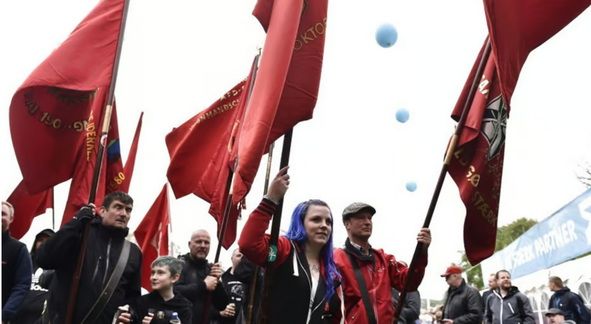
International Workers’ Day – Arbejdernes internationale kampdag
May 1st was established as the International Workers’ Day at the congress of the Socialist International in 1889 – the 100th anniversary of the French Revolution. In Denmark, the day is celebrated on May 1st with demonstrations in the largest cities.
A special significance and tradition in Denmark is the celebration of May 1st in Common (Fælledparken) in Copenhagen, where the first Workers’ Day was held in 1890. This is due to the Battle of Fælleden on May 5th, 1872, when the Copenhagen workers demonstrated for better working conditions.
The police prohibited the workers from marching through the streets with banners and flags unfurled. They were also not allowed to sing. However, the police gave permission to be in the northern part of Fælledparken – but on certain conditions: They were only allowed to discuss the demand for the introduction of an 8-hour working day. Beer or anything else was not allowed to be sold, and the square had to be cleaned up afterwards. Although neither private nor public employers would give workers time off to participate, between 30,000 and 40,000 people turned out.
May Day is a completely normal working day, and therefore you are only entitled to take time off if it has been agreed.
Night of May 4
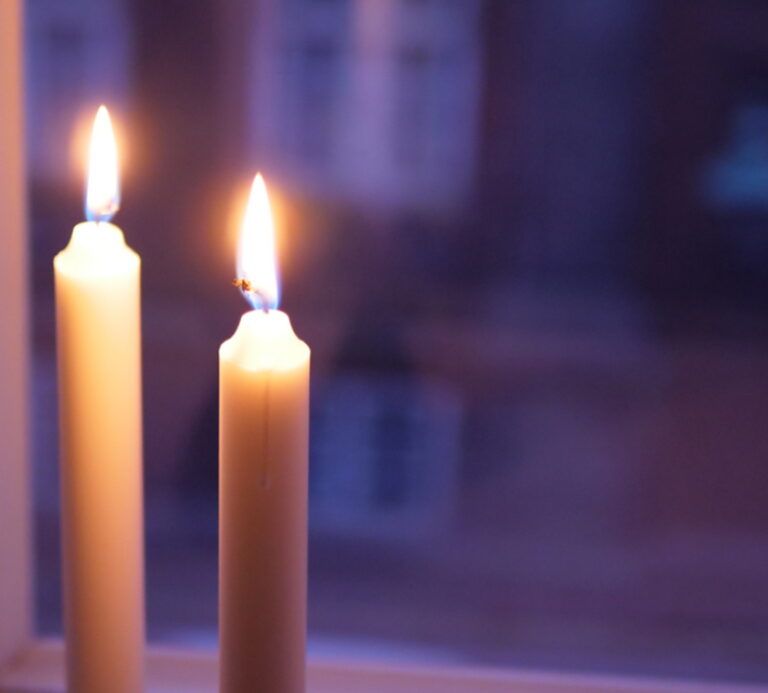
The liberation of Denmark 1945
The custom of lighting windows on the evening of May 4th dates back to the end of World War II. At 8:36 p.m. on May 4th, 1945, Johannes G. Sørensen read the long-awaited message of freedom over the radio from London, that the German troops in Denmark had surrendered. Five years of German occupation were over. Many have told how people ran into the streets, tore down the blackout curtains and spontaneously lit lights in the windows.
This has since been repeated every year on the eve of liberation. In retrospect, historians have debated to what extent there were lights in the windows in 1945, as many years of rationing and a shortage of candles made it almost impossible for this to happen. However, one newspaper wrote that “in the evening candles were lit in many windows, living warm lights, which were lit for the victory of peace and humanity”, but it was not until 1946 onwards that the custom became widespread, among other things. as a result of organized commemorations and municipal distribution of candles.
This seasonal ritual can be performed individually, but together. The custom is a simple but symbolic ritual, and the regular action expresses as a social phenomenon both community and hope, which this year takes on a whole new dimension.
Second Sunday in May
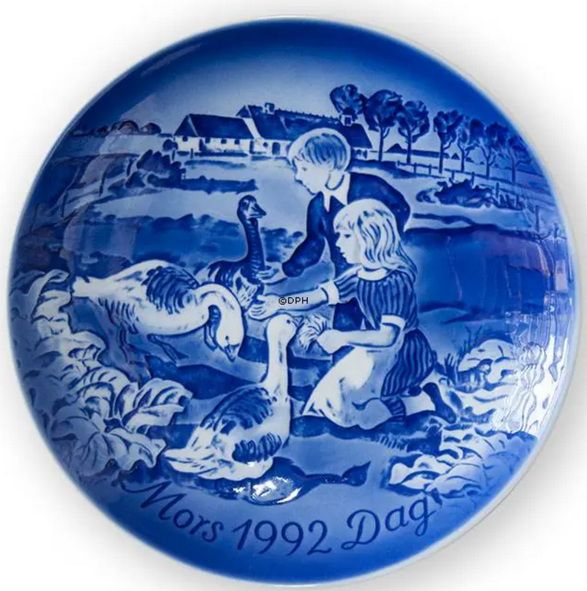
Mother’s Day – Mors dag
Mother’s Day came to Denmark in 1910, when the Baptist church in Rønne, Bornholm invited people to celebrate “Mother’s Day”. 400 people attended the celebration.
In 1929, the Parliament clerk Christian Svenningsen spiced up the tradition with his own idea for events to raise money for the benefit of war widows and mothers who had lost a son. He had fought as a soldier in the US army during The Great War and then heard about the new tradition from his fellow soldiers. Later, the money went to the social-humanitarian organization, Mødrehjælpen [Mothers’ Aid]. The tradition of giving a Mother’s Day gift dates back to this time.
May – The 4th Friday after Easter

Great Prayer Day – Store bededag
Great Prayer Day is a special Danish public holiday, set for the fourth Friday after Easter. It was a public holiday throughout the Danish Empire. In 2023, the Danish Parliament decided to abolish Great Prayer Day as a public holiday in Denmark with effect from 2024; however, the law does not apply to the Faroe Islands and Greenland, which thus retain the public holiday.
Great Prayer Day was enacted into law in 1686 based on even older traditions, namely weekly fast days on Wednesdays and Fridays, recurring annual prayer days in the spring, and extraordinary prayer days that were held over several days in Denmark and Norway in the 16th and 17th centuries in the event of threatening situations.
Both Great Prayer Day and the other prayer days of the year were heralded the evening before by the great storm bells of the churches. This was a signal that all trade had to cease and that pubs had to close. The prayer day itself was for a long time a strict fast day.
Going to the ramparts (Christianshavns Vold) to hear the church bells is a Copenhagen tradition that can be traced back to 1747, when Vor Frue Kirke got a new carillon.
According to the law, Great Prayer Day was a day off, to be dedicated to penance and prayer. Copenhagen bakers therefore came up with the idea of baking some wheat buds that could be heated and eaten the next day. Gradually, it became common throughout the country to eat the warm wheat on Thursday – the evening of the Great Prayer Day. This is still very popular even despite the abolition of Great Prayer Day being a the public holiday.
June (50 days after Easter)

Whitsun – Pinse
Whitsun is 50 days after Easter. It is the holiday when Christians remember that the Holy Spirit came to Jesus’ disciples. Whitsun is not associated with any special traditions in Denmark. Though, some people love to watch the “Whitsun Sun” dancing. The tradition of watching the sun dance at dawn dates back to the 19th century in Copenhagen, where people would head out to Frederiksberg’s ‘small gardens’ when Tivoli and other amusement parks closed. Here the party continued until sunrise. Some singing societies have also had a custom of getting up early and going to the forest to sing and watch the sun dance.
June 5
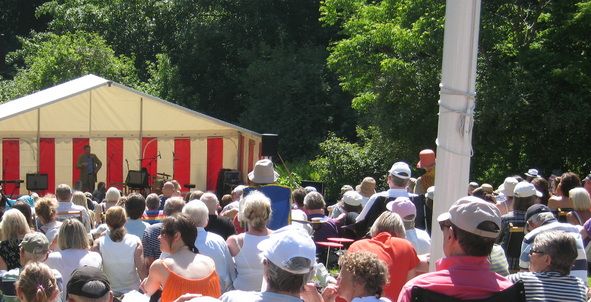
Constitution Day – Grundlovsdag
Constitution Day is the day when we celebrate our constitution, when the average Dane was granted a lot of rights over himself. Today, Constitution Day is celebrated by many Danes all over the country, but as with May 1st, it is most often the trade unions and political parties that hold events on Constitution Day. In contrast to May 1st, the liberal and conservative parties also celebrate Constitution Day.
Already in the years after the introduction of the Constitution in 1849, the anniversary was marked as a special, nationally marked holiday. Open-air meetings and rallies were held, but the newspapers also marked the day.
June 5

Father’s Day – Fars dag
Father’s Day was introduced in Sweden in 1931, and a few years later – in 1935 – the day came to Denmark. The Swedes chose to follow the American placement of the day, and placed it on the 3rd Sunday in June. In Denmark it became Constitution Day, i.e. June 5, although with a small attempt at moving it in 1947.
June 23
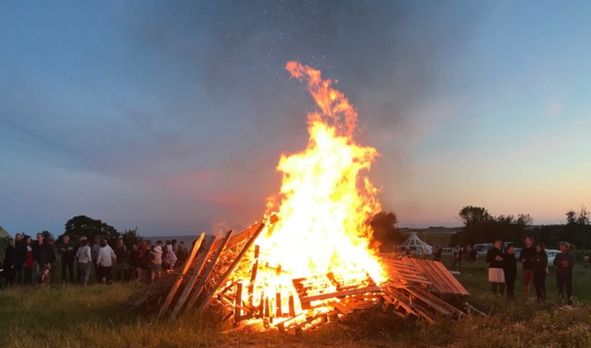
Midsummer Day – Sankt Hans Aften
Midsummer Eve [Sankt Hans Aften] is June 23, the night before St. John’s Day [Sankt Hans’], which is said to be the birthday of St. John the Baptist [Johannes Døberen]. The day has been celebrated in the Nordic countries for many centuries by gathering in squares or fields to light bonfires, dance and sing carols. Later, in 1770, St. John’s Day itself was abolished as a public holiday, but people still continued to celebrate the Midsummer Eve in different ways, right up to the present day. The light from the bonfire was originally interpreted as a symbol of John, who pointed out Christ in a world of darkness. The bonfire was supposed to function as a beacon and to keep evil forces away.
The connection between Midsummer Eve and witches is old, although the burning of witch dolls on Midsummer Eve is a newer tradition, first seen in Denmark from 1880-1900. A tradition that came to Denmark with some German craftsmen. In addition to Denmark, witch dolls are still burned in some places in Germany and Czechoslovakia. Many have reinterpreted the burning to mean that they do not burn the witch, but send her to Bloksbjerg.
Today, Midsummer Eve is celebrated with bonfires, communal singing, and speeches at events in both public and private settings.
End of June
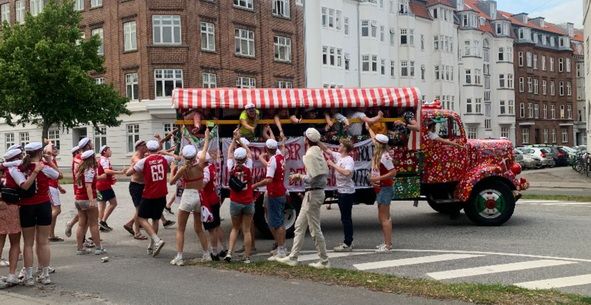
Students’ binge – Studenterkørsel
When the students graduate from high school in Denmark, it is tradition to load all of them unto a large truck and go to each student’s home and have a beer or two. The parents will also serve snacks to the students. A typical student driving lasts from 10 to 12 hours.
Traditionally the truck will be decorated with beech branches, but nowadays decorations mostly consist of large banners made by the students, with text that either mocks their own performance in school, or reference alcohol intake or sexual activity – often in the form of rhymes. Of course, ballons and flags are also used for decoration, and large stereos are brought along on the trucks to play music loudly while driving around.
“Studenterkørsel” has existed in Denmark for around a hundred years, gaining popularity after WWII – though back then, horse carriages were the norm, rather than trucks.
Night of October 31
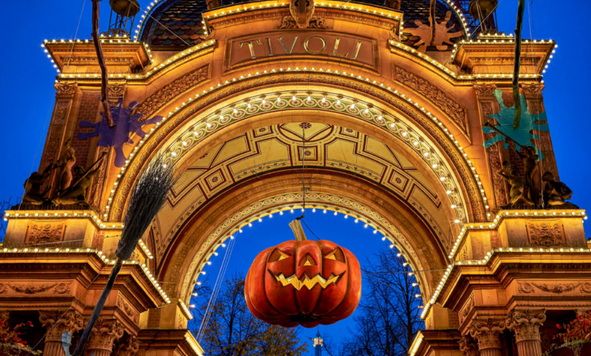
Halloween – Allehelgensaften
Halloween has become a Danish custom with great popular support. In a few decades, the Danes have adopted the American custom as if it were our own.
There are probably still many who are a little confused about this “tradition” because it did not exist when they were in school. But if it makes sense to us today, and it is repeated year after year, it is a tradition. If the Danes have had an easy time adopting it, it is probably because it has to do with community. We already have strong association activities.
November 1
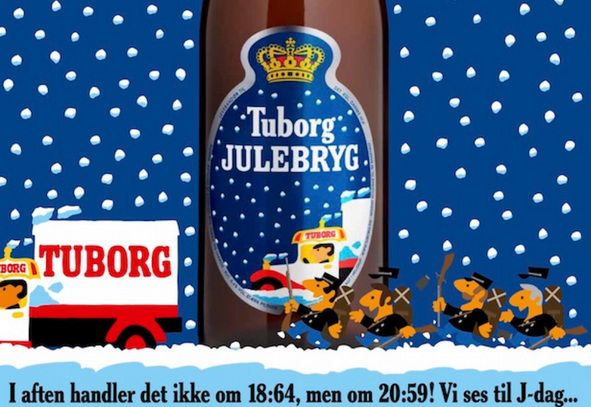
J-day – J-dag
At J-day – “J” stands for “Juleøl” (Christmas Ale) – the Christmas Ale from the Tuborg brewery is released at 8:59 pm. In many places for free this evening, served by people dressed in blue elf costumes. The day has become an unofficial holiday of sorts, starting in 1990. At first, the day of release was on the second Wednesday in November, but was later changed to the first Friday in November. As Denmark is very fond of beer, many people look forward to the Christmas Ale every year. Numerous other breweries are also releasing their own Christmas Ales now, to join in on the popular celebration.
Night of November 11
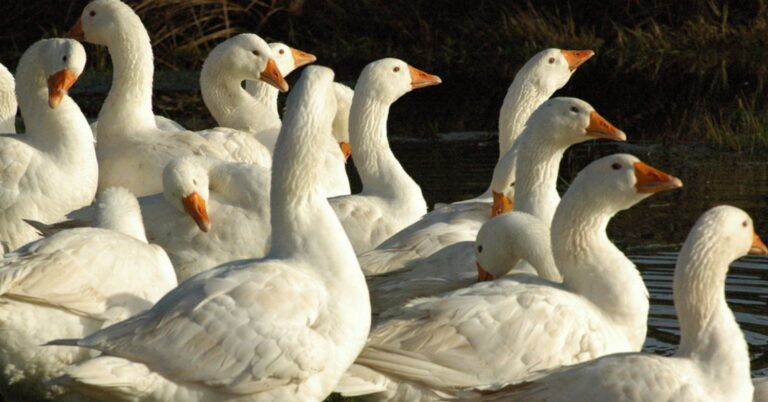
Martinmas eve – Mortens aften
Every year, on November 10, it is Martinmas Eve – an evening in memory of Bishop Martin of Tours, who did not want to be a bishop. In Denmark, the story of the bishop in the goose pen was first printed in 1616, and Martin of Tours was given the name Morten Bisp [Bishop]. So in other words, Morten Bisp hid among a flock of geese to avoid being appointed bishop, and on Martinmas Eve we punish the geese for revealing his hiding place.
Eating St. Martin’s goose was a well-known custom in Denmark in the 18th century. This is known from a dining regulation from a Lolland hospital, which dictates roast goose every Martinmas Eve. Many Danes celebrate Martinmas by eating duck in the company of friends and/or family, the evening before Martinmas on November 11. Goose has been replaced by duck by the vast majority of Danes – probably because the size of the duck is better suited to Danish households.
Next to Christmas Eve (where around 50% of all ducks are sold), the Martinmas Eve is one of the most established traditions in Danish cuisine. Based on these figures, approximately a quarter of Danish households keep the tradition alive.
December
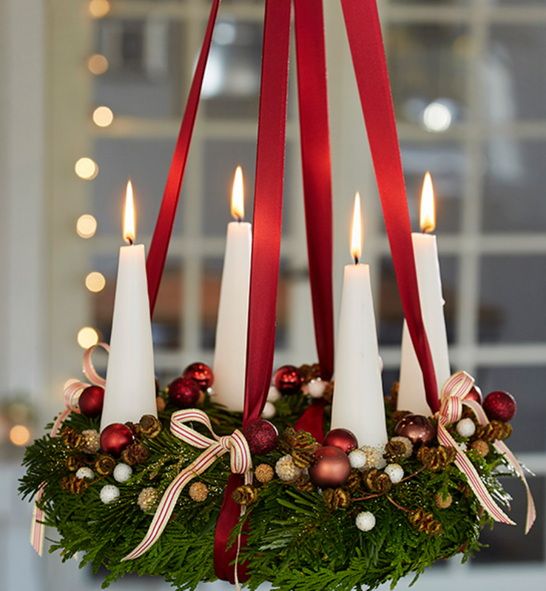
The four Sundays in Advent
The first Sunday in Advent is four Sundays before Christmas Eve. Advent is thus the period leading up to Christmas, marking the waiting time until Jesus’ birth on December 25.
Many Danish families have an Advent wreath, which traditionally consists of a small wreath made of fir branches, in which four candles are placed. One candle for each Sunday in Advent. On the first Sunday in Advent, the first candle is lit, on the second Sunday the second candle and so on. Like the Christmas tree, the Advent wreath has its roots in Germany, and came to Denmark around the time of the Great War. During the occupation from 1940 to 1945, the Advent wreath’s popularity grew. With its red ribbons and white candles, it almost became a national symbol.
It is a fixed tradition in many of the country’s large cities to light the city’s Christmas tree on the first Sunday in Advent, because on the first Sunday in Advent most people feel that Christmas has begun, and then gift shopping, Christmas parties and other Christmas events begin in the days leading up to Christmas.
December 24
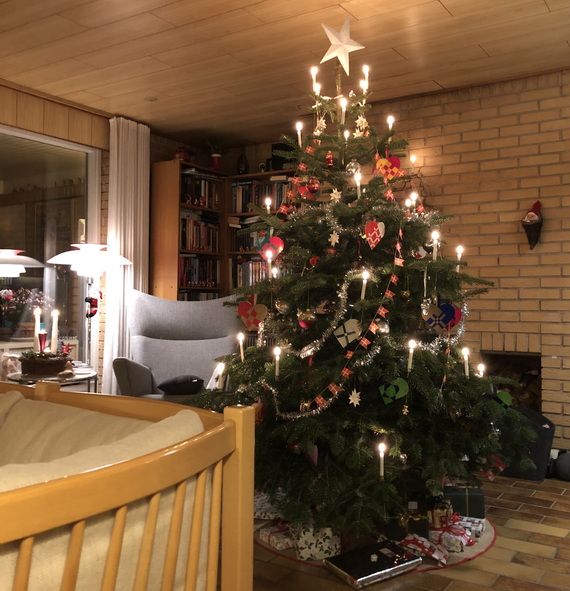
Christmas – Jul
Christmas is the holiday in Denmark with the most traditions. Most people spend Christmas with their family – not their friends.
As early as October, shops start displaying Christmas items and Christmas really begins around December 1.
Before December 1, you should have:
- Calendar lights and Christmas decorations in order, so that they are ready when the Christmas month begins
- Advent calendar for the children with a door for each day December 1-24. Often with chocolate or candy
- A parcel calendar is also a regular Christmas tradition in many Danish homes. Both for children and adults
- Advent calendars can possibly replace the parcel calendar
During December:
- Decorating for Christmas. Some buy their Christmas decorations, while others make them themselves, or use the Christmas decorations that their children have made at school or kindergarten
- It is a little different when people pick up their Christmas tree and how they do it. It also varies when people put it in the living room and decorate it
- Many people bake their own Christmas cakes. In many families, baking together is also a regular part of the Christmas fun
- Christmas lunch with friends and colleagues
- Christmas calendar on TV: A regular Christmas tradition for many is also to follow a Christmas calendar on TV. There are several for children, but one or more are also broadcast for adults.
The day before Christmas Eve (Little Christmas Eve)- December 23:
- Decorating the Christmas tree: Many have made it a regular Christmas tradition to put the Christmas tree in the living room and decorate it the day before Christmas Eve
- Preparing food for Christmas Eve: Many people roast duck for Christmas Eve and have rice pudding, where the leftovers can be used for rice á l’impératice the next day
The culmination is Christmas Eve – December 24:
- Some people go to church in the afternoon on Christmas Eve
Watch Disney’s Christmas show, which is often quite enjoyable for both children and adults. It has been a regular on the airwaves for as long as I can remember. - Eat a nice Christmas dinner for dinner. Typically, duck, goose, turkey or roast pork is eaten, as well as red cabbage, white cabbage or kale, brown gravy and white and brown potatoes. For dessert, there is usually rice á l’impératice with an almond gift for the person who finds the whole almond in the dessert
- Dance and sing around the Christmas tree. I think most people dance and sing Christmas carols around the Christmas tree before the highlight of the evening comes
- The highlight of the evening for many is undoubtedly the gifts. For most people, this happens after dinner and after dancing around the Christmas tree. Some families with small children may go a little extra with the gifts, as one of the adults may dress up as Santa Claus to make the evening very special for them
After Christmas Eve, there are a couple more holidays in the form of Christmas Day and Boxing Day. There are many traditions for the different age groups:
- There are often Christmas dinners with the family that everyone participates in
- The young people often go into town one of several days to meet their friends who may have “come home” to celebrate Christmas
- The children often play with their Christmas presents
- And otherwise it is probably just relaxation in front of the TV and with lots of Christmas sweets
- There are also some who go to church on Christmas Day, that is, December 25, when Jesus was born
The days December 27-30
- Many employees take the days off to get a nice long holiday
Night of December 31
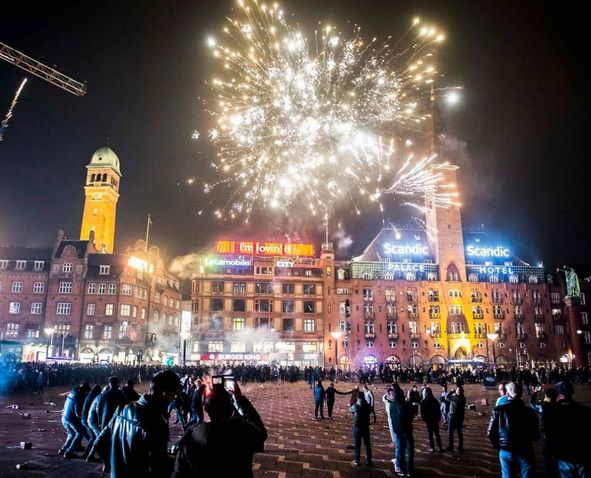
New Year’s eve. – Nytårsaften
On December 31st, at 6:00 PM, all the Danish streets are deserted, and everyone is watching TV, and it’s not to watch football, but the Queen/King’s New Year’s speech. It was Christian IX who started the tradition of a New Year’s speech, back in the 1880s. In 1941, the New Year’s speech was broadcast on the radio for the first time, and the first time it was shown on TV was in 1958, when it was given by Frederik IX.
As the clock approaches 8:00 PM, a steady stream of fireworks will begin to be heard around the country. Many Danes fire off their private arsenals, and they spend the evening firing impressive, advanced rockets into the sky.
Before the Danes are completely ready to enter the new year, many want to have “the same procedure as last year,” which means watching the short film “Dinner for One,” which is broadcast on DR every year. Although the little sketch was recorded in 1963, the film was first shown in Denmark in 1973, and today it is still shown on TV every year as Danes wait for the new year. There was one year when DR decided not to show the film, but after strong protests from all Danes, it has been shown every year since.
When the clock strikes midnight, the “kransekage” (a marzipan-based cake) comes out, it is probably the day of the year when Danes eat the most “kransekage”, it is served with champagne. This dessert comes in different shapes and sizes, the traditional tower, or in much more complicated shapes.
Many Danes have a rather funny New Year’s tradition, where they literally jump into the new year from a chair.
When the Danes hear the town hall bells strike 12 times, the entire nation breaks into song, and the same two songs are always sung, “King Christian stood at the high mast” and “Welcome, the year of the Lord!”
And the fireworks culminate.
